These Flowers Aren’t Just Pretty To Look At—They’re Edible, Too
Below, Erin Bunting, author of the upcoming cookbook The Edible Flower: A Modern Guide to Growing, Cooking and Eating Edible Flowers and co-founder of The Edible Flower, an Ireland-based supper club, organic smallholding, and cooking and growing school, gives advice on cooking with edible flowers, with recipe ideas and tips for where to find them and how to store them.
The Best Types of Edible Flowers
There are many types of flowers that work well in food and drinks, but if you’re new to ingestible blooms, it can be difficult to know which ones to spring for. To help, Bunting shares her top 10 favorite flowers to use in the kitchen.
1. Borage
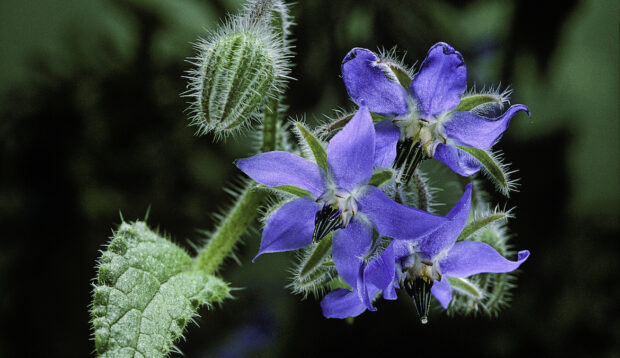
Borages are blue, star-shaped flowers with a flavor reminiscent of cucumber. According to Bunting, they make a welcome addition to cucumber or zucchini salads, and they can elevate a classic gin and tonic or Pimm’s cup cocktail. When using borage flowers in food or drinks, Bunting recommends removing the sepal, the leaf located beneath the petals.
Flavor: Mild cucumber taste
2. Calendula
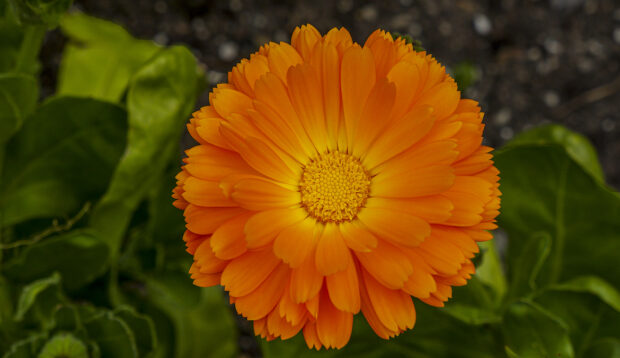
Calendula, or pot marigold, range in colors from orange and yellow to pink and cream. They taste peppery when eaten fresh, but when dried, they taste something like mushroom, imparting an umami taste to food. Calendula plays well with almost any vegetable, Bunting says, and she uses them in salads or on canapés, as well as to accompany egg dishes. (For instance, she adds their petals to her omelets.) You can press the flower petals to decorate cakes, too.
Flavor: Peppery taste when fresh; umami taste when dried
3. Cornflower

Cornflowers, or bachelor’s buttons, come in a riot of vivid colors, like pink, blue, and burgundy—and they retain their color when dried, Bunting says, making for beautiful floral confetti. When using the flower in food, it imparts a mild clove-like flavor to both savory and sweet fare. Just pick the petals and mix them into rice dishes, or use them as garnish for cakes and other desserts. In addition to these, Bunting mentions you can use dried cornflower petals in herbal tea.
Flavor: Mild, clove-like taste
4. Dahlias
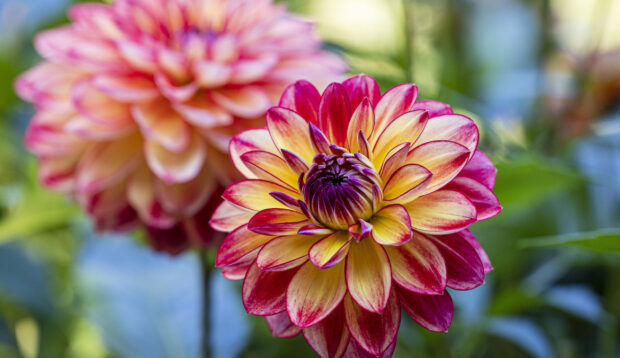
With their lively colors and showy petals, dahlias look almost too pretty to eat, but don’t let that stop you from using them in your food. “Before they were grown for their blooms,” says Bunting, “they were actually grown for their edible tubers.” She adds that they taste like celery, with a nutty flavor. Use the whole flower as decoration for cakes, or pick off the petals and mix them into lentil or grain dishes.
Flavor: Celery-like taste
5. Dianthus
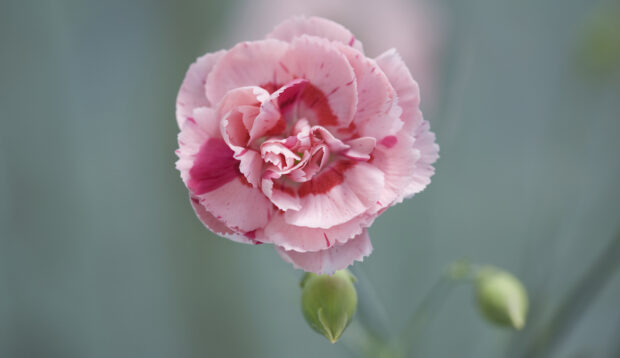
Dianthus, nicknamed “pinks” for their vibrant pink color, belong to the carnation family, and the fragrant flowers “taste of warming spices and cloves,” says Bunting. When using the flowers for food or drinks, she likes using them to make a syrup, which she then adds into cocktails or uses as a glaze for cakes and enriched breads.
Flavor: Reminiscent of warming spices and cloves
6. Elderflower

Floral and fruity, elderflower is ideal “for cordial and champagne, of course,” says Bunting, though you can also infuse it into cream for panna cotta, ice cream, or sorbets. She also recommends dipping and deep-frying them in tempura batter to make fritters.
Flavor: Floral and fruity taste
7. Lavender
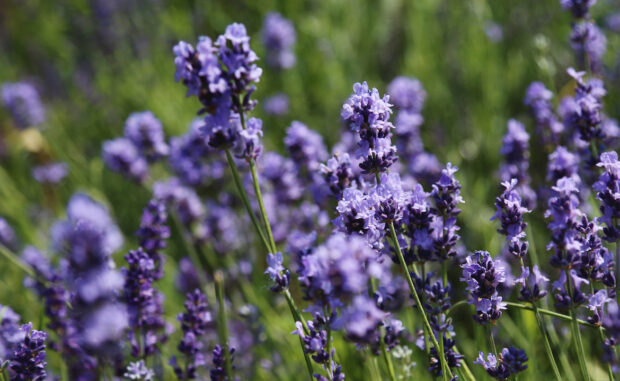
Lovely lavender, known for its ability inducing calm and sleep, also makes for a wonderful addition to your dishes. The flavor of lavender is reminiscent of rosemary, and it works as well in savory foods as in sweets. Bunting recommends trying to roast protein, like chicken or lamb, with lavender. She also says that you can make biscuits with lavender; include it in panna cotta; or you can take a page from Bunting, who makes “a delicious lavender and chocolate sorbet.”
Flavor: Tastes similar to rosemary
8. Nasturtium
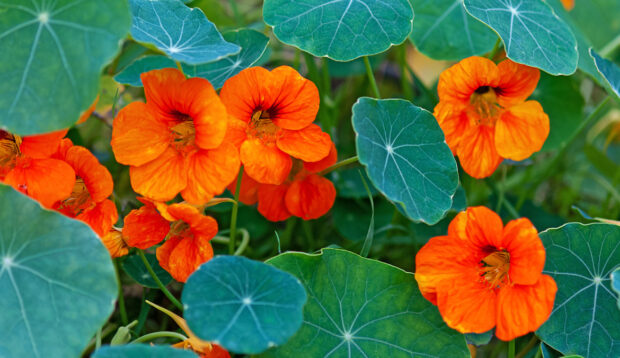
Red, orange, yellow, pink—nasturtium flowers come in a range of hues that imparts vibrant color and a peppery flavor to food. In addition to the flower, you can eat its leaves, which are both great over salads, pastas, or grain dishes. You can also use the leaves to make pesto or salsa verde. Bunting also suggests pickling the flower’s green seed pods, which can stand in as an alternative to capers.
Flavor: Peppery taste
9. Roses
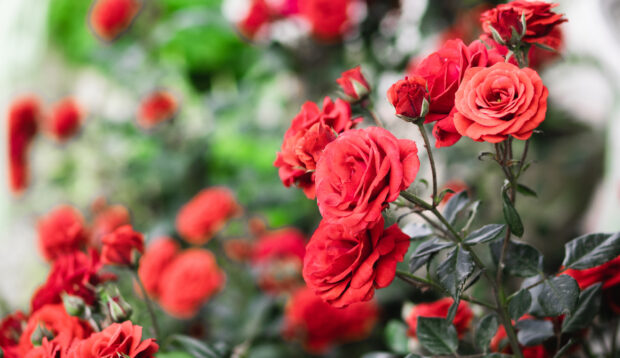
A rose by any other name would taste just as sweet, whether in savory or sweet dishes. Bunting says that all roses are edible, but she prefers wild hedge-grown varieties, like Rosa rugosa. You can candy rose petals and use them as the finishing touch on cakes, or you can make rose sugar or rose syrup—which, Bunting says is “lovely in cocktails or lemonade.” What’s more? Dried rose petals make a wonderful addition to teas as well as Middle Eastern or Moroccan spice blends, like ras el hanout or harissa paste.
Flavor: Tastes like they smell
10. Violas

Cheerful and charming, cool-weather violas are edible, just like their siblings, pansies. While there are plenty of varieties to choose from, most usually taste something like lettuce, says Bunting. She recommends using it on canapés or cakes—or consider adding them to Vietnamese summer rolls to add (even more) color to the recipe. She adds that you can also press the individual flowers to dress up desserts.
Flavor: Tastes like lettuce
How To Use Flowers in Food and Drinks
There are many possibilities when it comes to using flowers for cooking. One of the simplest ways is to use them as a decorative garnish. Bunting says you can use flower petals to top off salads, toast, canapés, soup, or mix them into food—say, dishes where rice, pasta, or lentils take center stage. Flowers also have their place in desserts, whether as a garnish or as an ingredient. Many sweet-flavored flowers can be incorporated into sugars or made into delicious syrups, which you can mix into ice cream, sorbets, or cakes, or make into ganaches, mousses, ice creams, or glazes.
Bunting says that you can also sip your blooms by adding them to drinks, like cocktails or tea. You can likewise use flower petals (either fresh or dried) as a garnish, or infuse them into syrups that you can pour straight into your beverage of choice.
Where To Find Flowers You Can Eat
You’ll find flowers most anywhere, but it’s crucial to source your blooms from a reputable company that grows flowers for edibility, says Bunting. You might also want to consider purchasing flowers that are grown organically. “People do grow edible flowers non-organically, but my recommendation is to try and find someone growing organically,” she says. She explains that flowers are typically eaten as is—they aren’t cooked or processed further by you—and if you buy organic, you won’t have to worry about having to remove edible layers that might have residual chemicals.
Another tip from Bunting? Try and find a local seller. “If you’re using [flowers] fresh, they don’t ship well—they do need to be kept cool.” You can also purchase dried flowers, though Bunting mentions that you want to ensure they are freshly dried. “The fresher things are dried, the more flavor you get,” she says.
Alternatively, think about growing your own flowers. “Even if you have a very small amount of space, like a balcony or a window box, a great thing about growing edible flowers is that you’re getting both that edibility and the beauty,” she says.
Whether you’re looking to outsource or grow flowers you can eat, you’ll always want to clean them before use if you’ll be eating them fresh. “I would dust off any little insects by just giving them a little shake, but I wouldn’t generally wash them because they would just turn to mush,” says Bunting.
Can you forage your own flowers?
While you can certainly forage flowers you can eat, Bunting says “it’s best to be knowledgeable about what you’re picking.” She adds that those who are unfamiliar with foraging might want to start out with a field or identification guide, or better yet, venture out with an experienced forager. “If you’ve never experienced [foraging] in the wild before, or if you’re not a person who grows lots of plants, it can be confusing, so I do think it’s worth getting advice,” she says.
When foraging for flowers, Bunting adds that you’ll also want to be mindful of where you’re picking. Avoid picking them from private gardens or parks with strict regulations without permission. You’ll also want to avoid picking flowers from where people are walking a lot of dogs. “You don’t know if dogs might have been peeing on them, so you don’t want to pick those,” she says. In addition to these, “you want to make sure you’re picking from a place where they are using pest or weed control to be safe.”
How To Properly Store Flowers
Bunting says that fresh flowers need to be kept cool—and if you are growing your own flowers, you can pop them in the fridge to make them last longer. She recommends storing them in an air-tight container with a sheet of damp kitchen roll, which “adds a little extra moisture.”
Storing flowers in the fridge should keep them fresh for a short period of time, but if you want to preserve them for longer, Bunting recommends drying (or purchasing dried flowers) or pressing them, which should make flowers last anywhere from 10 days or four weeks. “If you don’t have a flower press, just take two sheets of paper, and press them between the pages of a large book, keeping them somewhere warm and dry,” she says. “Once they’re pressed, you can use the pressed flowers to decorate cakes or biscuits.”
For longer-term preservation, Bunting suggests turning your flowers into a syrup. “You’re looking for the same volume of petals to water, except for maybe lavender, which has a very strong flavor,” she says. “Basically, you soak them in boiling water, leaving them overnight, straining off the petals, and then mixing it with an equal quantity of sugar.” She adds that you can use it in all sorts of ways—in cocktails, to soak a cake or babka, or to flavor panna cotta. She even says that you can use some flower-infused syrups, such as lavender, as a glaze for roasted meats, like chicken.
5 Recipes To Inspire You With Flowers You Can Eat
Nasturtium Garlic Bread

This garlic bread recipe from Bunting’s website, The Edible Kitchen, incorporates peppery nasturtiums, which elevate the easy dish instantly.
Get the recipe: Nasturtium Garlic Bread
Lavender Lemonade

This lemonade recipe from The Cookie Rookie infuses the thirst-quenching beverage with the fragrant lavender, while imparting it with a gorgeous purple color.
Get the recipe: Lavender Lemonade
Cucumber Salad With Borage Flowers
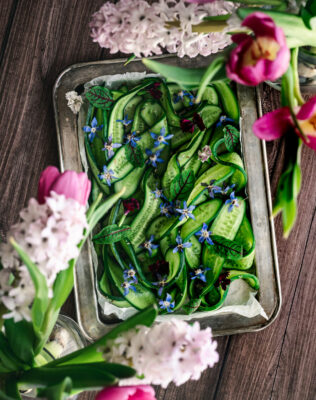
This cucumber salad recipe from Frolic And Fare uses a few simple ingredients, but the result is something delicious and visually appealing, thanks to the addition of star-shape borage.
Get the recipe: Cucumber Salad With Borage Flowers
Wild Rose Petal Jam
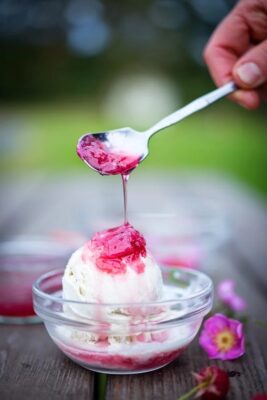
This rose petal jam recipe from Feasting At Home can jazz up everything from scones and crepes to ice cream and cakes.
Get the recipe: Wild Rose Petal Jam
Elderflower Syrup

This elderflower syrup recipe from The Busy Baker combines elderflower with lemons, and you can incorporate it in creams and cake frosting, or use it in teas or cocktails.
Get the recipe: Elderflower Syrup
Our editors independently select these products. Making a purchase through our links may earn Well+Good a commission.
For more latest Food & Drinks News Click Here

